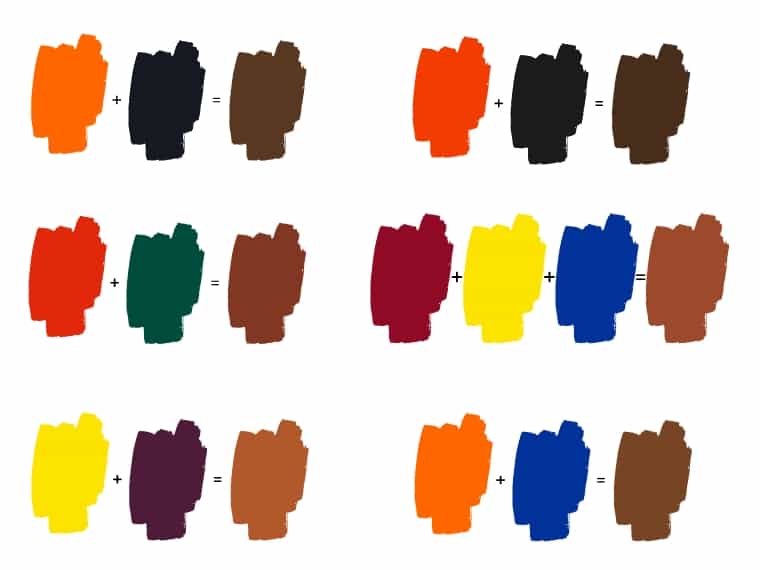Are you wondering what colors make brown? In today’s article, you’ll learn how to make brown paint and which colors, when mixed together, produce brown, whether you want to mix two or three colors.
Brown is one of the most necessary colors in any artist’s palette. That’s why knowing how to make brown by mixing other colors is essential. Besides saving money and resources, learning to make different brown tones will help you create light effects and transitions or paint different things.
These include natural elements (wood, soil, or animals), skin tones, or even hair. You’re aware of how many brown things exist in nature. However, learning how to make brown paint is more complicated than other colors.
Let’s find out what colors make brown paint and how you can get different shades and tones of this color.
What Colors Make Brown?
Learning how to make brown colors can be more complex than you expect. If you’ve arrived here, you’ve probably wondered what two colors make brown. Well, there are several answers. Depending on the mix you choose, you will get different shades of brown.
To understand how to make brown, look at the color wheel and analyze the color’s relationship. This way, a good understanding of color theory will help you get the shade of brown you want.
Primary Colors
Primary colors are the base colors, or the building blocks of all color models, whether we’re talking about traditional art, graphics, or light.
In any color model, primary colors cannot be made by mixing other colors. An essential requirement of a set of three primaries is that no combination of any two matches the third.
When it comes to painting, the primary colors are red, yellow, and blue. Mixed in pairs, the secondary colors result. So how can you make brown using primary colors? Mix the three primary colors in equal proportions, and you get a shade of brown.
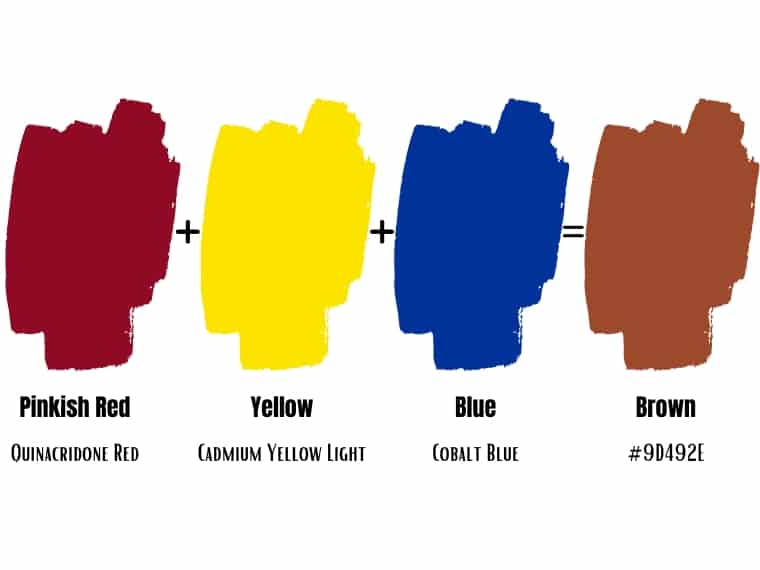
To lighten the shade, add a little white paint to the mixture.
If you use different ratios of red, yellow, and blue in your mix, you’ll get different shades of brown.
When it comes to light, things get complicated. Light works with red, green, and blue as primary colors. The three colors are the primary additive colors. They are different because they have been chosen according to the three types of cones in the retina of the eye that are sensitive to red, green, and blue light.
In the RGB color system, the brown color with the hex code #964B00 is created from 58.8% red and 29.4% green. Dark brown, with the hex code #654321, also known as Otter Brown, is composed of 39.6% red, 26.3% green, and 12.9% blue.
So, when it comes to light, things are more straightforward. Any color is made up of different intensities of red, green, and blue light.
When it comes to printing, the three colors are cyan, magenta, and yellow. These are subtractive colors. Interestingly, mixing two subtractive primary colors results in an additive primary color.
Black is added to the printing process to improve blackness and lower costs.
In the CMYK color model, brown consists of 0% cyan, 50% magenta, 100% yellow, and 41.2% black. In order to make a darker brown, this color system uses a mix of 34% magenta, 67% yellow, and 60% black.
So, while brown is a mix of three colors in the RGB system, in the CMYK system, this color is created from two primary colors with the addition of black.
When it comes to painting, brown can only be made from two colors – a primary and its complementary color on the color wheel – a secondary color.
Secondary Colors
Secondary colors are the result of mixing two primary colors. For example, in painting, secondary colors include orange, green, and purple.
Here’s how secondary colors are created in traditional art:
- Yellow and red make orange;
- Blue and yellow make green;
- Red and blue make purple.
Brown can be created by mixing two secondary colors or a primary with a secondary color.
For example, mixing purple and orange makes Russet – a shade of brown with a hint of red.
To make light brown, mix orange and green paint in equal proportions.
There are two ways to make brown by mixing only secondary colors:
- Orange and purple make reddish-brown, known as Russet;
- Orange and green make light brown.
Considering primary and secondary colors, what two other colors make brown?
There are three options to make brown by mixing two colors: combining yellow and purple, red and green, or blue and orange. However, the most colorful brown results from mixing yellow and purple.
Complementary Colors
Complementary colors represent a color harmony scheme that involves choosing two colors facing each other on the color wheel. They provide the strongest contrast when paired together. However, when mixed together, they neutralize each other.
The primary complementary colors are:
- Green and red;
- Blue and orange;
- Purple and yellow.
Any mixture of primary complementary colors makes brown, including:
- Blue (primary) and orange (secondary);
- Yellow (primary) and purple (secondary);
- Red (primary) and green (secondary);
What Two Colors Make Brown?
The easiest way to make brown is to mix a primary color with its complementary color, like red and green, yellow and purple, or blue and orange.
Red and Green Make Brown
What color do red and green make when mixed?
Mixing red and green results in a muddy brown. For the best result, mix Cobalt green with Cadmium red light.
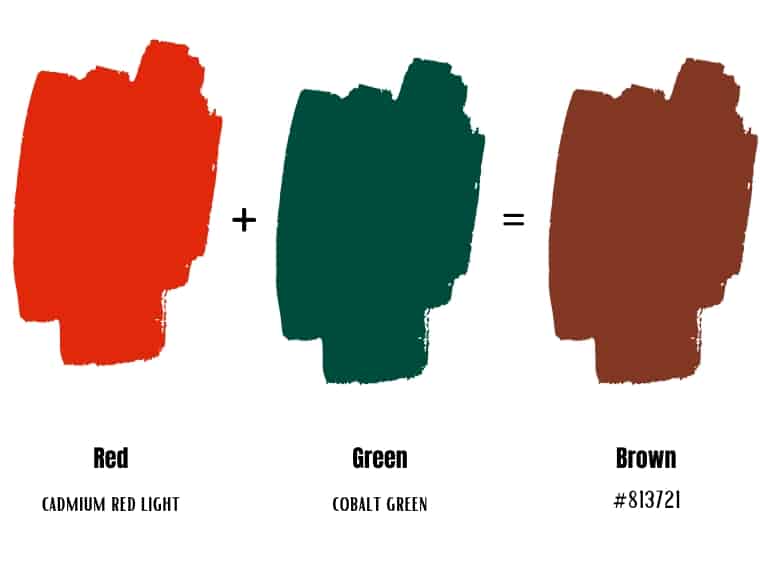
Blue and Orange Make Brown
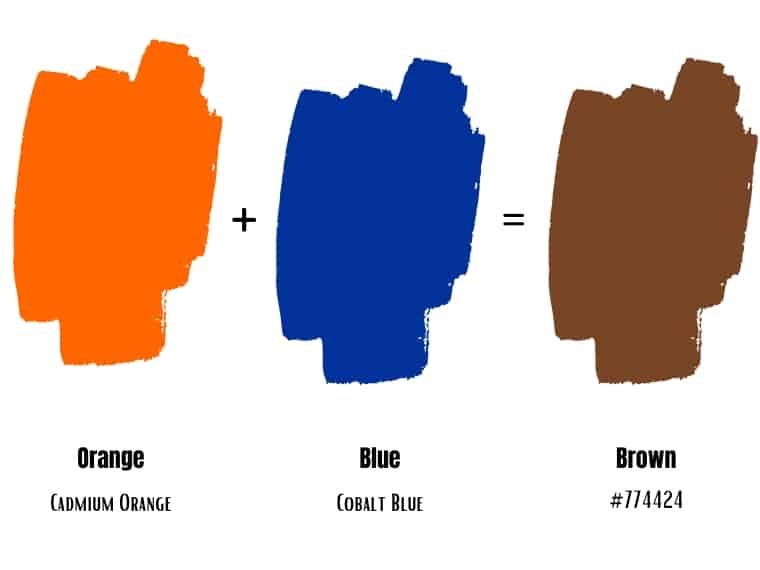
Blue and orange make a brown with green undertones.
Yellow and Purple Make Brown
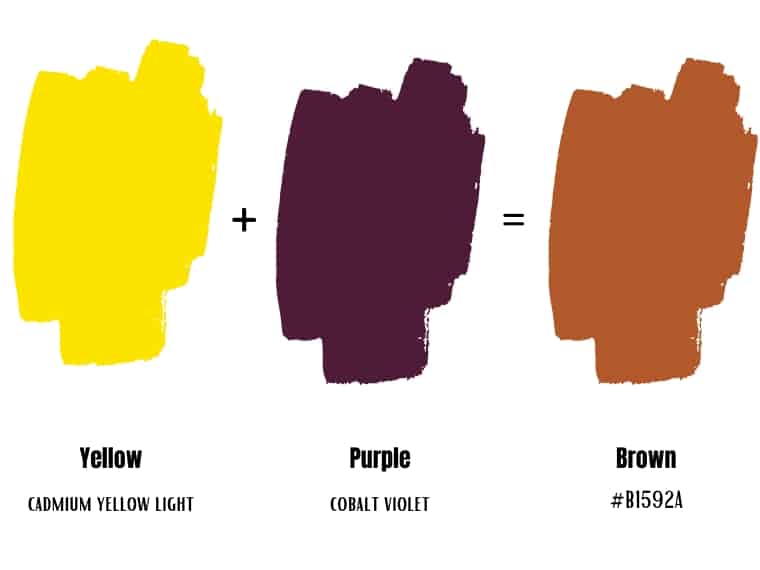
Yellow and purple make the most colorful brown.
You can also make brown by mixing the three primary colors: red, yellow, and blue. If you don’t have the three colors,
So, what colors make brown?
- Yellow + purple = brown
- Green + red = brown
- Blue + orange = brown
What Other Colors Make Brown?
In addition to the above combinations, two other mixtures make brown. Here they are:
Orange and Black Make Brown
Orange and black mixed together make brown, especially a reddish mid-brown.
If you want to make a dark brown, mix cadmium orange and Payine’s gray.
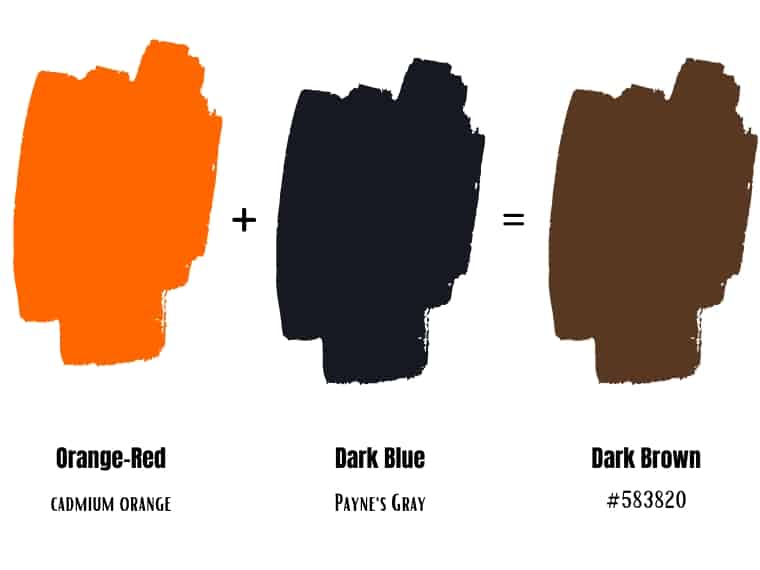
But what happens when you mix purple and orange? This intriguing combination yields a reddish-brown paint.
Red, Yellow, and Black Make Brown
Brown can be created by combining red, yellow, and black. Because orange and black result in brown, it’s evident that the colors that result in orange, when combined with black, result in brown.
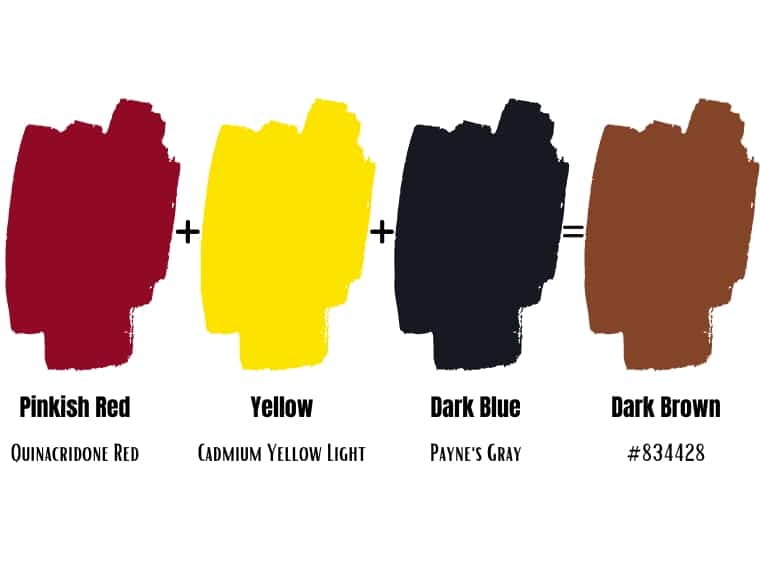
Mixing a pinkish red (Quinacridone red) with yellow (Cadmium yellow light) and a dark grayish blue (Payne’s gray) will result in a dark brown.
How to Make a Light or Dark Brown Paint?
Before discussing color temperature, here are some important aspects of color theory. Although brown is a generic term to describe an earthy color, the brown tone you need can be bright, dull, light, or dark. So, it is essential to understand that any brown color palette can contain different shades depending on hue, saturation, and value.
- Hue refers to the base color or color family. The main hues are red, yellow, and blue, the primary colors.
- Saturation, also called intensity, describes how bright and vibrant a color is.
- Color value refers to how light or dark a color is. For example, shades of brown can be light, medium, or dark. To change the color value or its intensity, you can create shades, tints, and tones of brown.
To create a brown tint, add white to the mix. This will increase the lightness. To get a brown shade, add black paint.
On the other hand, to produce a brown tone, mix the final color with a shade of gray.
So, while the shade is the darkest, the tint is the lightest. Adding black helps to create a dark brown paint or a shade of brown, while adding white will result in a light brown paint or brown tint.
How to Make a Light Brown Paint?
To make a light brown, create your base by mixing the three primary colors. Once mixed, adjust the brightness with a splash of white paint. Add a splash of white paint until you reach the desired shade of brown.
How to Make a Dark Brown Paint?
Wondering what colors make dark brown? You can mix a red-orange (Vermilion) with black, orange-red with dark blue (Payne’s gray), or yellow with violet and black.
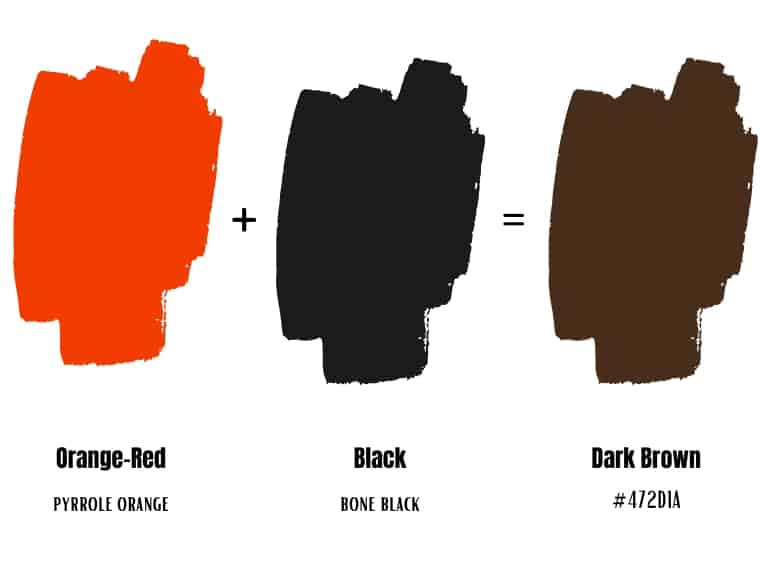
If you want to make a dark brown only from primaries, create your final color as shown above and then add very little black paint. Because black is made by mixing all the colors, black paint contains different pigments.
A more straightforward solution to make dark brown is to use an orange base, then add blue paint until you reach the desired result.
If you mix blue and orange in equal proportions, you can add a little purple. So you can use black or other dark colors to darken the brown.
Another way to create dark brown is by mixing red with dark green. For example, you can mix Cadmium red light with Hookers green.
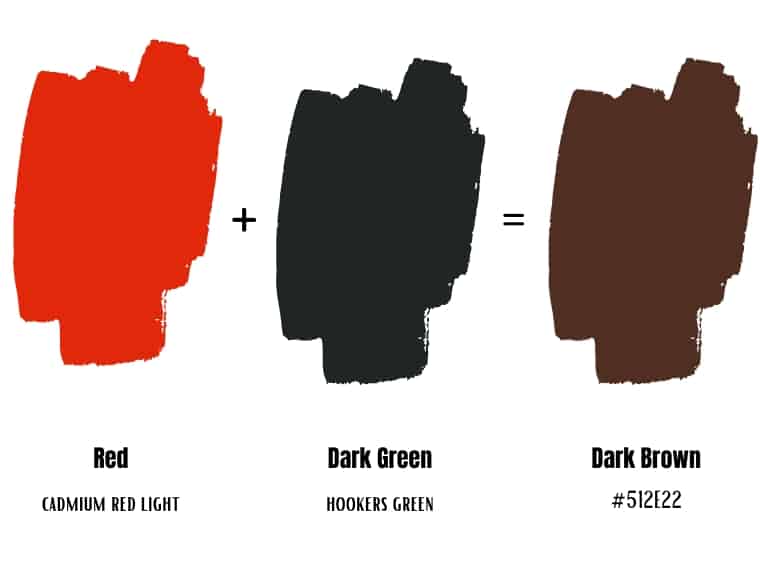
This is the result—another beautiful brown mix.
How to Make a Cool or Warm Brown?
Like any color, brown evokes different emotions and can change moods. Brown evokes feelings of comfort and protection.
If we consider the color meanings, brown is associated with wisdom, reliability, stability, and honesty. It is the color that simplifies and grounds.
Temperature impacts the colors’ emotions. Warm colors include yellow, red, and orange, while cool colors are on the other side of the color wheel, including blue, green, and purple.
While warm colors evoke happiness, warmth, and energy, cool colors evoke calm and relaxation.
If you’ve added too much red to your mixture and the resulting brown is too warm, you can add blue paint to balance its temperature.
Infographic with Colors That Make Brown
Here is an infographic with the colors that make brown:
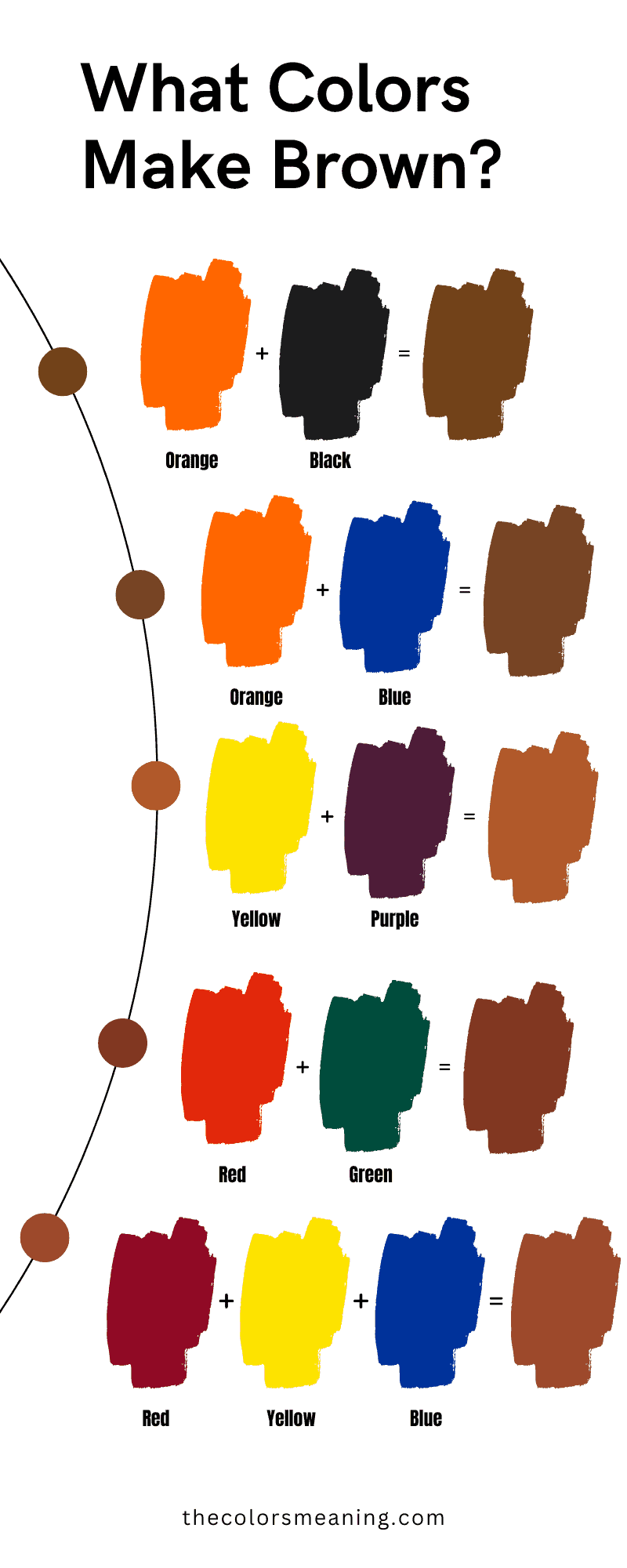
You’ve figured out what colors make brown, right?
How to Make Brown Paint With Acrylics
Brown is a must-have when painting with acrylics. But, to save money, you can do it yourself. You need a paintbrush, a palette, and a palette knife.
If you have all three primary colors, the easiest way to do brown paint with acrylics is the following:
- Start with red and yellow paint on your mixing palette or container. Mix the two colors together thoroughly until you achieve a shade of orange.
- Add a small amount of blue paint to the orange mixture. Mix the colors together until you achieve the desired shade of brown.
- Test the brown paint by painting a small amount onto a piece of paper or canvas. If the color you get is too light, add more blue. If it’s too dark, add more red or yellow.
Here are some useful tips:
- Use a small amount of blue paint, as it can easily overpower the other colors and make the brown too dark.
- Start with equal parts red and yellow paint and adjust as needed.
- If you don’t have all three primary colors, you can still make brown paint by mixing complementary colors. Mix green and red or purple and yellow to create brown.
How to Make Brown Paint With Watercolors
Start by making a small puddle of water where you will do the mixing, and start adding color.
To make brown paint with watercolors, use the primary colors:
- Mix an equal red and yellow watercolor paint ratio on your mixing palette or container. Mix the colors together thoroughly until you achieve a shade of orange.
- Add a small amount of blue watercolor paint to the orange mixture. Mix the colors together until you achieve the desired shade of brown.
- Add more red and yellow paint if the brown paint is too light. If it’s too dark, add more water to lighten the color.
You will get lighter or darker shades depending on your blue paint. If the resulting brown is too cool or dark, supplement with a bit of red or yellow to balance the temperature or brightness.
Of course, when learning to make brown paint, you could use purple mixed with yellow as a base. Or you could use green mixed with red as a base. As a tip, yellow and purple make the most beautiful brown.
Advantages of Mixing a Brown Color Palette
Mixing a brown color palette is important for a few reasons:
- Creating realistic shadows: Brown is often used to create realistic shadows in paintings. So, you can create shadows that have depth and dimension, making your artwork more lifelike.
- Adding warmth to a painting: Brown can add warmth and richness, especially when combined with warm colors like red and yellow. Thus, you can add depth and interest to their paintings.
- Saving money: By mixing your own brown colors, you can save money as well as simplify your palette. Rather than purchasing a tube of brown paint, which may only have one shade, you can mix different colors you already have to create a range of different browns.
- Become a better artist: Mixing a brown color palette can also be a creative and expressive process. By experimenting with different combinations of colors, you can create different brown tones that can add depth and interest to your artwork.
Moreover, mixing a brown color palette is essential in art because it allows artists to create a wide range of natural and earthy colors. In addition, it helps you create realistic shadows, add warmth and richness to your artwork, simplify the palette, and, of course, become a better artist.
Last Words on What Colors Make Brown
colorsThere are three colors to mix to make brown, and these are the primary colors: red, yellow, and blue.
Suppose you’re wondering what two colors make brown. In that case, the short answer is the primary complementary colors: red and green, yellow and purple, or blue and orange. However, the best method is trial and error to get to the perfect brown.
Did you enjoy this article about what colors make brown? Please help us spread the word. Share this article with your friends who might be interested in this topic. Thank you!

